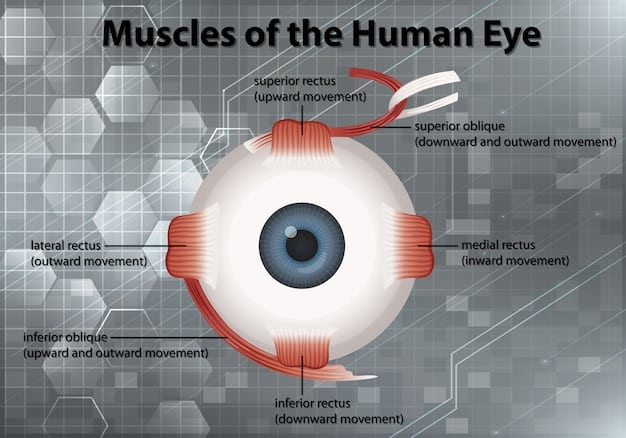Senior Eye Health: AMD Early Detection & Treatment Options

Timely diagnosis and effective management of Age-Related Macular Degeneration (AMD) are crucial for preserving vision in seniors, as early detection and various treatment options can significantly slow its progression and mitigate vision loss.
As we age, our bodies undergo numerous changes, and our eyes are no exception. For many seniors, maintaining good vision becomes a paramount concern, especially with the increasing prevalence of conditions like Age-Related Macular Degeneration (AMD). Understanding Senior Eye Health: Early Detection and Treatment Options for Age-Related Macular Degeneration is not merely about managing a disease but about preserving quality of life and independence.
Understanding Age-Related Macular Degeneration (AMD)
Age-Related Macular Degeneration (AMD) is a progressive eye condition that affects the macula, the central part of the retina responsible for sharp, detailed vision. This vital area allows us to see faces, read, and drive. When the macula deteriorates, these crucial activities become challenging, profoundly impacting an individual’s daily life and independence.
AMD is primarily categorized into two forms: dry (atrophic) and wet (neovascular). The dry form is far more common, accounting for about 85-90% of all AMD cases. It progresses slowly over many years, characterized by the thinning of the macula and the presence of drusen – yellow deposits that accumulate under the retina.
Types of AMD and Their Characteristics
The distinction between dry and wet AMD is critical for understanding its progression and treatment approaches.
- Dry AMD: This form involves the gradual breakdown of the light-sensitive cells in the macula. Vision loss is typically slow and progressive, often starting with blurred central vision or difficulty seeing in low light. While it can lead to severe vision loss over time, it generally does not cause the rapid, significant changes seen in wet AMD.
- Wet AMD: Although less common, wet AMD is far more aggressive and can lead to rapid and severe vision loss. It occurs when abnormal blood vessels grow under the retina, leaking fluid and blood into the macula. This leakage distorts vision, causing straight lines to appear wavy and blind spots to develop in the central field of vision. Prompt treatment is crucial to prevent irreversible damage.
Understanding these fundamental differences helps both patients and caregivers prepare for the potential impacts and necessary interventions. The onset of wet AMD often requires immediate medical attention due to its destructive potential, contrasting with the slower, more insidious nature of dry AMD.
The exact causes of AMD are still under extensive research, but a combination of genetic and environmental factors appears to play a significant role. Age is the most prominent risk factor, but smoking, genetics, obesity, and a diet low in essential nutrients can also increase susceptibility. Recognizing these risk factors can empower individuals to take proactive steps toward prevention and early management.
In summary, AMD presents a significant challenge to senior eye health. Its two forms, dry and wet, demand different levels of urgency and types of intervention, making early and accurate diagnosis paramount for effective management and preservation of precious sight.

Early Detection: Recognizing the Signs and Symptoms
Early detection plays a pivotal role in managing Age-Related Macular Degeneration and mitigating significant vision loss. Many individuals might dismiss early symptoms as natural signs of aging, but a proactive approach to recognizing these changes can make a substantial difference. Regular eye examinations are the cornerstone of early detection, even before symptoms become noticeable.
Subtle Indicators of AMD
The initial signs of AMD can be subtle and might go unnoticed until the condition has progressed. Awareness of these early indicators is crucial for timely intervention.
- Blurred or Distorted Central Vision: This is one of the most common early symptoms. Objects in the central field of vision may appear blurry or warped, making activities like reading or recognizing faces difficult. Straight lines might appear wavy or crooked.
- Difficulty Adapting to Low Light: Seniors with early AMD might find it challenging to adjust their vision when moving from a brightly lit area to a dimly lit one, or they may need more light for reading or close-up tasks.
- Reduced Intensity or Brightness of Colors: Colors might seem less vibrant or faded than before, indicating a change in the light-sensing cells of the macula.
- A Scotoma (Blind Spot) in Central Vision: As AMD progresses, a dark or empty area may appear in the center of the visual field. This blind spot can significantly interfere with daily activities.
These symptoms may progress slowly with dry AMD, but in wet AMD, changes can be sudden and dramatic. Any sudden onset of vision changes warrants immediate medical attention from an ophthalmologist.
Beyond self-monitoring for symptoms, routine comprehensive eye exams are essential. These exams typically include a visual acuity test, dilated eye exam, and often an Amsler grid test. The Amsler grid is a simple tool that patients can use at home to monitor for central vision changes, such as wavy lines or missing areas, which can indicate macular issues. Regular use of this grid can provide early warning signs between professional examinations.
Furthermore, understanding one’s risk factors is a form of early detection. Individuals with a family history of AMD, smokers, or those with certain genetic predispositions should be particularly vigilant and engage in more frequent screenings. Lifestyle modifications, such as quitting smoking and adopting a diet rich in fruits, vegetables, and omega-3 fatty acids, can also contribute to reducing the risk and potentially slowing the progression of the disease.
In essence, early detection of AMD is a partnership between the individual and their healthcare provider. Recognizing symptoms, utilizing home monitoring tools like the Amsler grid, and adhering to a schedule of comprehensive eye exams are all vital steps in identifying AMD at its earliest, most treatable stages.
Diagnostic Procedures for AMD
When symptoms of Age-Related Macular Degeneration arise or during routine screenings, several diagnostic procedures are employed by ophthalmologists to confirm the presence of AMD, determine its type (dry or wet), and assess its severity. These tests provide critical information that guides treatment decisions, ensuring the most effective care for maintaining vision.
Key Diagnostic Tools and What They Reveal
A thorough diagnosis typically involves a combination of tests, each offering a unique perspective on the health of the macula.
- Dilated Eye Exam: This is a fundamental part of the examination. Eye drops are used to widen the pupils, allowing the ophthalmologist a clear view of the retina, macula, and optic nerve. During this examination, the doctor can identify drusen, which are characteristic yellow deposits under the retina associated with AMD, as well as changes to the macula tissue.
- Amsler Grid Test: This simple but effective test involves a grid of straight lines with a dot in the center. The patient covers one eye and stares at the dot. If the lines appear wavy, distorted, or if there are blank spots, it may indicate macular damage. This test helps detect early changes in central vision and is often used for self-monitoring at home.
- Optical Coherence Tomography (OCT): OCT is a non-invasive imaging test that uses light waves to create cross-sectional images of the retina. It provides highly detailed pictures of the retina’s layers, allowing the doctor to detect fluid accumulation, swelling, or new blood vessel growth under the macula, which are hallmarks of wet AMD. OCT is indispensable for monitoring the effectiveness of treatments for wet AMD.
- Fluorescein Angiography: For this test, a special dye is injected into a vein in the arm. The dye travels to the blood vessels in the eye, and a special camera takes rapid photographs. These images reveal any abnormal blood vessels (neovascularization) or leakage under the macula, confirming the diagnosis of wet AMD and helping to pinpoint the exact location of the leakage.
Each of these diagnostic tools contributes to a comprehensive understanding of the patient’s condition. The dilated eye exam provides an initial assessment, while the Amsler grid allows for ongoing self-monitoring. OCT offers unparalleled detail of retinal anatomy, and fluorescein angiography precisely maps abnormal vascular activity. The combination of these tests enables doctors to differentiate between dry and wet AMD with high accuracy, which is crucial given their vastly different treatment pathways.
Technological advancements continue to refine these diagnostic methods, leading to even earlier and more precise detection of AMD. For instance, enhanced OCT imaging can now detect subtle changes even before significant symptoms emerge. Patients should discuss any concerns with their eye care professional and adhere to recommended screening schedules to ensure that any potential AMD is identified and addressed promptly.
Ultimately, a precise and early diagnosis lays the groundwork for effective management, allowing for timely interventions that can preserve vision and maintain the quality of life for individuals living with Age-Related Macular Degeneration.
Treatment Options for Dry AMD
Unlike wet AMD, there isn’t a single definitive medical treatment for dry Age-Related Macular Degeneration that can restore lost vision or reverse the damage. However, management of dry AMD primarily focuses on slowing its progression and protecting remaining vision. This often involves specific nutritional strategies and lifestyle adjustments designed to support overall eye health.
Nutritional Interventions and Lifestyle Modifications
Research, particularly the Age-Related Eye Disease Studies (AREDS and AREDS2), has provided significant insights into the role of nutrition in managing dry AMD.
- AREDS/AREDS2 Formulations: For individuals with intermediate or advanced dry AMD in one or both eyes, daily supplementation with a specific combination of vitamins and minerals has been shown to reduce the risk of progression to advanced AMD by about 25%. These formulations typically include:
- Vitamin C
- Vitamin E
- Zinc
- Copper
- Lutein and Zeaxanthin (in AREDS2)
It’s crucial for patients to consult with their ophthalmologist before starting any supplements, as certain vitamins (like high-dose Vitamin E) might interact with medications or be contraindicated for specific health conditions.
- Dietary Recommendations: Beyond supplements, adopting a diet rich in eye-healthy nutrients is encouraged. This includes a variety of colorful fruits and vegetables, especially leafy greens like spinach, kale, and collard greens, which are excellent sources of lutein and zeaxanthin. Foods rich in omega-3 fatty acids, such as fatty fish (salmon, tuna, mackerel), can also contribute to overall eye health.
- Lifestyle Changes: Several lifestyle factors can influence the progression of dry AMD:
- Smoking Cessation: Smoking is a significant risk factor for AMD progression. Quitting smoking is one of the most impactful steps an individual can take to protect their vision.
- Blood Pressure and Cholesterol Management: Maintaining healthy blood pressure and cholesterol levels can reduce the risk of AMD progression and improve overall cardiovascular health.
- UV Protection: Wearing sunglasses that block 99-100% of UVA and UVB rays can help protect the eyes from harmful sun exposure, which is believed to be a contributing factor to AMD.
- Regular Exercise: Physical activity can improve circulation and overall health, potentially benefiting eye health.
While these interventions cannot reverse the damage caused by dry AMD, they play a vital role in slowing its advance and preserving existing vision. Regular monitoring by an eye care professional remains essential to track any changes and ensure treatment plans are adjusted as needed. Patients should be encouraged to maintain a consistent follow-up schedule and adhere to recommended nutritional and lifestyle guidelines.
Managing dry AMD is a long-term commitment that combines medical guidance with personal responsibility. By embracing these strategies, individuals can proactively protect their vision and maintain their quality of life for as long as possible.
Treatment Options for Wet AMD
Wet Age-Related Macular Degeneration, though less common than its dry counterpart, is far more aggressive and can cause rapid, severe vision loss if left untreated. Fortunately, significant advancements in medical therapies over the past two decades have revolutionized the management of wet AMD, offering effective ways to stabilize vision and, in some cases, even improve it.
Advanced Therapies for Wet AMD
The primary goal of wet AMD treatment is to stop the growth of abnormal blood vessels and prevent them from leaking fluid or blood into the macula. This is largely achieved through anti-VEGF therapy.
- Anti-VEGF Injections: This is the cornerstone of wet AMD treatment. VEGF (Vascular Endothelial Growth Factor) is a protein that stimulates the growth of new, abnormal blood vessels. Anti-VEGF medications block this protein, thereby inhibiting vessel growth and reducing leakage. Common anti-VEGF drugs include:
- Ranibizumab (Lucentis)
- Aflibercept (Eylea)
- Bevacizumab (Avastin) (often used off-label)
- Faricimab (Vabysmo) (targets both VEGF and Ang-2)
These medications are administered directly into the vitreous humor of the eye via a very fine needle during a simple, in-office procedure. While the idea of an eye injection might sound daunting, it is generally well-tolerated, and the eye is numbed beforehand to minimize discomfort. Patients typically require a series of initial injections, often monthly, followed by a maintenance schedule determined by their ophthalmologist based on the response to treatment. The frequency of injections can vary widely among individuals, often moving to extended intervals or a “treat-and-extend” protocol once the condition stabilizes.
- Photodynamic Therapy (PDT): Once a more common treatment, PDT is now generally reserved for specific cases, often in combination with anti-VEGF injections. This therapy involves injecting a light-sensitive drug (verteporfin) into the bloodstream, which then accumulates in the abnormal blood vessels. A non-thermal laser is then applied to the affected area in the eye, activating the drug and selectively closing off these vessels without damaging the surrounding healthy retinal tissue.
The choice of treatment, particularly the specific anti-VEGF drug and injection frequency, is highly individualized and depends on factors such as the severity of the AMD, the patient’s response to treatment, and any existing comorbidities. Regular follow-up appointments, including OCT scans, are essential to monitor the effectiveness of the treatment and to adjust the injection schedule as needed.
While anti-VEGF injections represent a groundbreaking advancement, they do require ongoing commitment from the patient due to the need for repeated treatments. However, the benefits – stabilization of vision, prevention of further loss, and even potential improvement – significantly outweigh the inconvenience for most individuals. The goal is to maximize and preserve the patient’s visual function, allowing them to maintain their independence and quality of life.
Research continues to explore new, longer-acting anti-VEGF agents, gene therapies, and implantable devices that could reduce the frequency of injections, further improving patient convenience and outcomes. These ongoing efforts underscore the dynamic nature of wet AMD treatment, promising even better options in the future.
Living with AMD: Support and Low Vision Aids
Living with Age-Related Macular Degeneration, whether dry or wet, presents unique challenges, but it doesn’t mean the end of an active and fulfilling life. A robust support system and access to specialized low vision aids can significantly enhance independence and daily function for individuals experiencing vision loss due to AMD. The focus shifts from curing the disease to adapting to its effects and maximizing remaining vision.
Adapting to Vision Loss and Maximizing Independence
Adjusting to the impact of AMD begins with understanding that help is available. Many resources are designed to assist individuals in continuing their daily activities and maintaining their quality of life.
- Low Vision Specialists: These professionals are experts in helping people with vision impairment. They can assess individual needs and recommend a range of low vision aids, along with training on how to use them effectively. Their guidance is invaluable in navigating the challenges presented by central vision loss.
- Magnification Devices: A variety of magnifiers exist, from handheld and stand magnifiers for reading to electronic video magnifiers (CCTVs) that display magnified text or objects on a screen. These are particularly useful for tasks requiring detailed central vision, such as reading mail, labels, or recipes.
- Lighting Enhancements: Good lighting is crucial for individuals with AMD. Bright, glare-free illumination can make a significant difference in visibility. This includes task lighting that can be directed precisely where needed, as well as minimizing shadows.
- Computer and Smartphone Adaptations: Modern technology offers numerous built-in accessibility features such as text-to-speech functions, screen magnification, and high-contrast modes. Dedicated software and apps can further enhance readability and usability for those with impaired central vision.
- Assistive Technology: Beyond magnification, other assistive devices can help with specific tasks. Large-print books, talking clocks, bold-lined paper, and specialized kitchen gadgets can simplify daily routines. Navigation apps designed for visually impaired individuals can also aid in mobility.
- Support Groups and Counseling: Connecting with others who have AMD can provide immense emotional support and practical advice. Support groups offer a forum to share experiences, coping strategies, and information about local resources. Psychological counseling can also help individuals adjust to vision changes and manage any associated emotional distress.
Moreover, simple modifications around the home can significantly improve safety and ease of movement. This includes enhancing contrast in living spaces (e.g., dark toilet seat on a light toilet), improving stair lighting, removing tripping hazards, and labeling items clearly. Maintaining an organized environment also reduces the frustration of searching for misplaced objects.
Embracing these adaptations and seeking out support services empowers individuals to remain engaged in their communities and continue pursuits they enjoy. While AMD can change how one interacts with the world, it does not have to diminish the richness of life. With the right tools and support, many seniors with AMD live fulfilling and independent lives.
Preventative Measures and Future Outlook
While Age-Related Macular Degeneration is often linked to genetic predisposition and the natural aging process, proactive preventative measures can play a significant role in reducing the risk of developing the condition or slowing its progression. The future outlook for AMD patients is also becoming increasingly optimistic with ongoing research and emerging therapies.
Strategies for Prevention and Hope for the Future
Adopting a healthy lifestyle is one of the most effective preventative strategies against AMD.
- Nutrient-Rich Diet: A diet abundant in fruits, vegetables, and omega-3 fatty acids is paramount. Specifically, foods rich in lutein and zeaxanthin, such as leafy green vegetables (spinach, kale, collard greens), corn, and eggs, are beneficial for macular health. Omega-3s found in fatty fish (salmon, tuna, mackerel) also contribute to overall eye health.
- Quit Smoking: Smoking is one of the strongest modifiable risk factors for AMD. Quitting dramatically reduces the risk of developing the disease and slows its progression in those already affected.
- Manage Underlying Health Conditions: Controlling blood pressure, cholesterol, and blood sugar levels through diet, exercise, and medication (if necessary) can indirectly protect eye health, as these conditions are often linked to vascular health which impacts the eyes.
- Regular Exercise: Physical activity improves circulation throughout the body, including the eyes, and can help maintain a healthy weight, both of which are beneficial for eye health.
- UV Protection: Wearing sunglasses that block 99-100% of UVA and UVB rays when outdoors can help protect the macula from harmful sun exposure, which is hypothesized to contribute to AMD.
- Regular Eye Examinations: Comprehensive dilated eye exams are crucial for early detection of AMD, especially for individuals over 50 or those with a family history of the disease. Early detection allows for timely intervention and better management outcomes.
The future of AMD treatment is promising, with a robust pipeline of research focused on novel therapies and long-acting solutions.
- Longer-Acting Anti-VEGF Drugs: Researchers are developing new anti-VEGF agents that can be effective for longer periods, potentially reducing the frequency of injections needed for wet AMD. This would significantly ease the burden on patients and improve adherence to treatment.
- Gene Therapy: Gene therapy holds immense promise for wet AMD. By introducing specific genes into the eye, scientists aim to enable the eye cells to produce their own anti-VEGF proteins, providing a continuous therapeutic effect and potentially eliminating the need for frequent injections. Some gene therapies are already in clinical trials.
- Stem Cell Research: Stem cell research is exploring ways to replace damaged retinal cells, offering hope for restoring vision loss in both dry and wet AMD. While still in early stages, this area of research could lead to transformative treatments.
- Neuroprotection: Strategies focused on protecting the existing retinal cells from damage are also being investigated, which could be beneficial for slowing the progression of dry AMD.
- Artificial Intelligence (AI): AI is being employed to improve early diagnosis and prediction of AMD progression through advanced image analysis from OCT scans, leading to more timely and precise interventions.
These preventative measures combined with the exciting advancements in treatment and research offer a hopeful future for individuals at risk of or living with AMD. Continued adherence to a healthy lifestyle and staying informed about new therapeutic options will be key to preserving vision and maintaining a high quality of life.
| Key Aspect | Brief Description |
|---|---|
| 👁️ Early Detection | Crucial for preserving vision; involves recognizing symptoms like blurred central vision and regular eye exams. |
| ✔️ Dry AMD Treatment | Focuses on slowing progression with AREDS/AREDS2 supplements and lifestyle changes. |
| 💧 Wet AMD Treatment | Primarily anti-VEGF injections to stop abnormal blood vessel growth and leakage. |
| 💡 Living with AMD | Utilizing low vision aids, adapting home environments, and seeking support for enhanced independence. |
Frequently Asked Questions about AMD
▼
Dry AMD involves the gradual thinning of the macula and vision loss, accounting for most cases. Wet AMD is less common but more severe, characterized by abnormal, leaky blood vessel growth under the retina, causing rapid and significant vision deterioration.
▼
Currently, there is no complete cure for AMD. However, treatments for wet AMD can effectively stop its progression and often improve vision. For dry AMD, interventions focus on slowing its advance and managing symptoms to preserve remaining vision.
▼
While not a guarantee, adopting a healthy lifestyle can reduce AMD risk. This includes quitting smoking, consuming a diet rich in leafy greens and fish, managing blood pressure, using UV protection, and engaging in regular physical activity.
▼
Seniors should ideally have comprehensive dilated eye exams annually, particularly if they have risk factors like a family history of AMD or are over 50. Your ophthalmologist can recommend a personalized screening schedule based on your individual risk profile.
▼
Anti-VEGF injections are the primary treatment for wet AMD. They involve administering medication directly into the eye to block Vascular Endothelial Growth Factor, a protein that stimulates abnormal blood vessel growth and leakage, thereby preserving vision.
Conclusion
Maintaining optimal Senior Eye Health: Early Detection and Treatment Options for Age-Related Macular Degeneration is a critical aspect of aging gracefully. While AMD presents significant challenges, advancements in diagnostic tools and treatment modalities offer substantial hope for preserving vision and maintaining a high quality of life. Proactive measures, including regular eye examinations, a balanced diet, and healthy lifestyle choices, are invaluable in mitigating risks and slowing disease progression. For those affected, a combination of medical therapies, low vision aids, and strong support networks ensures continued engagement and independence. The future of AMD research, with its focus on longer-acting treatments and innovative therapies, further brightens the outlook, promising even more effective solutions to safeguard precious sight for future generations.





